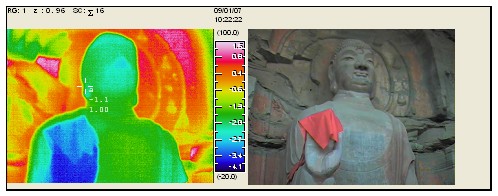Applications:
1 Inspection of the effect of grouting on painted mud and clay in painted land and water in Lantian, Shaanxi
Hollowing is an important factor that causes the murals to fall off, which endangers the preservation safety of the murals. The causes of emptying and damage to the murals are various. The infrared thermal imager can be used to easily detect the condition of the hollowing of the murals and evaluate the effectiveness of empty drum grouting. . In normal conditions, the infrared heat radiation of the entire mural surface should be uniform, reflected in the infrared thermal imaging, the color of the corresponding area is uniform, there is no obvious color difference, that is, there is no obvious color anomaly Area; When abnormal, such as the presence of voids, imperfections, honeycombs and other defects in the mural, in these parts, due to direct changes in the thermal conductivity of the mural surface and the wall, so there will be infrared relative to the normal part Abnormal radiation. In this case, the color reflected on the infrared thermal image is not uniform. Infrared image processing of the thermal anomaly area on the picture is judged by comparison with the visible light digital picture, and the actual location of the anomaly area can be visually observed. Fig. 2 shows the experimental heat map of empty drum grouting in the Lantian Water and Landscaping fresco. It can be clearly seen from the figure that there is a high temperature anomaly zone. This is an obvious empty zone. The high temperature anomaly zone indicates that the grouting effect is not ideal and it needs to be re-grouted.

Fig. 2 Thermal image of the Lantian Shuilou mural (heat map on the left and visible light on the right)
2 Distribution of capillary water in Jinchuan Bay Grottoes
The migration of capillary water has always been a culprit in the preservation of cultural relics. The Jinchuan Bay Grottoes is a three-step teaching engraved cave. The size and quantity of the engraved scripture should be one of the most important grottoes in the existing Chinese carved caves. However, due to the age, the erosion of capillary water, the phenomenon of weathering and shedding of the scriptures has become more and more serious, and local collapse has occurred. It is of great significance to explore the source and distribution of capillary water to protect the grottoes. If there is no capillary water erosion in the grotto, the color of the entire heat map is single and uniform. Figure 3 shows the heat distribution map of the capillary water on the back of the main Buddha in the Jinchuan Bay Grottoes. The red area in the figure is the capillary water dense area. Since the photographing time is winter, the temperature in the cave is below 0°C and the capillary water inside the rock body tends to condense. During the condensation process, a certain amount of heat is released to make the ambient temperature rise significantly, which is shown in the red region where the heat map is high in temperature. According to the heat map, different color areas can distinguish areas where capillary water activity is frequent.

Fig. 3 Thermal image of capillary water distribution in Jinchuan Bay grottoes (heat map on left and visible light on right)